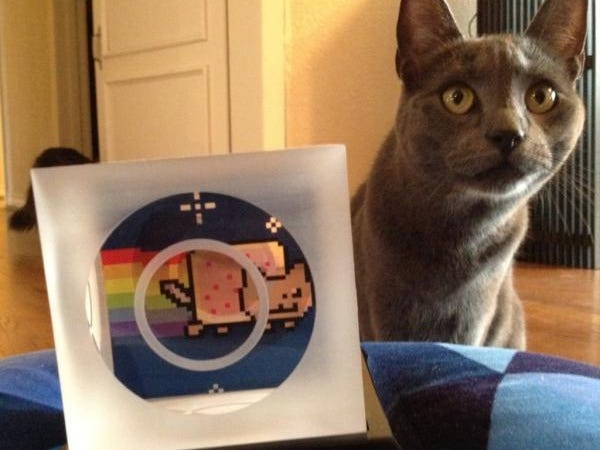- Chris Torres first posted pixelated art of his cat, Marty, in April of 2011.
- The collection is known as Nyan Cat. When it finally became an NFT, a bidding war took place.
- But Torres said frequent engagement with the community is a big part of the NFT’s success.
In 2011, Chris Torres began making pixelated art of a cat in a pastry body flying through space with a rainbow trail that he called Nyan Cat. The character was a depiction of his real cat, Marty, a Russian blue who died in 2012.
“There’s kind of an art form on the internet where it’s like a lot of cute animals that are paired with edible bodies, like apple bodies or cake bodies. So this one was kind of my take on it with a breakfast-pastry body,” Torres said.
Torres, a big fan of retro video games, said the image’s pixelated feature was inspired by Nintendo’s graphics.
He first posted the GIF on Twitter and Tumbler in April 2011. A few days later, someone made a YouTube video of Nyan Cat with music in the background. Torres told Insider he didn’t know who had created it at the time, though today he works with that creator. To date, that video has raked in almost 200 million views.
How Nyan Cat became an NFT collection
To create Nyan Cat, Torres used Adobe Fireworks, a now-discontinued program similar to Flash that he said crashed constantly. But it challenged him to preserve the traditional pixelated look.
Torres has made many iterations of Nyan Cat over the years but didn't do much with them.
Then he learned about non-fungible tokens through a friend who sent him a link to an article about SuperRare, an NFT marketplace. At first the idea that artists could get recognition and a decent amount of financial compensation for their work seemed too good to be true, he said.
"I was making art all the time, but I wasn't getting the recognition that I am getting today," Torres said.
He continued, "It was basically me versus the world in terms that I had people and companies approach me and they would just try to offer free publicity or they would say they would tweet about it or just post it somewhere. Then that would be my payment for them to use my work commercially. And you know, they make a lot of money out of it, to be frank."
Torres has always been an artist but never made enough from his artwork alone to pay the bills. He had a day job in IT, until he got laid off in April 2020 because of the COVID-19 pandemic, he said.
"I was literally living on unemployment and we had just bought a house and I was furloughed months before," Torres said. "So we were in a very stressful situation, but then the NFTs came along and just totally saved our lives."
SuperRare was the first NFT marketplace he applied to in January 2021, but it took the platform several months to accept him. While he was waiting, Foundation, another NFT marketplace, contacted him.
Torres took the old files he had of Nyan Cat and remastered them in HD quality but didn't change the pixelated feature. The artworks listed on Foundation were uploaded as MP4 files, while the main collection remained GIFs.
The first and original Nyan Cat sold for 300 ETH in February 2021 after an unexpected bidding war took place. That was equivalent to about $690,000, based on ETH's trading price of about $2,300 on Monday. Torres had initially set the floor price at 3 ETH.
By the time Torres entered the market, lots of people already knew Nyan Cat as a GIF or meme. But that wasn't what got Nyan Cat going as an NFT, Torres said.
"From there, not only was I just saying, 'Hey, this is my piece here,' I started interacting with people on Twitter, on Instagram, basically the NFT community," Torres said. "And I think that's what actually brought the value to the piece itself, just the whole community factor behind it all. People seeing that I'm active and not just here trying to make money."
In March 2021, just a month after Torres sold his NFT, the digital artist known as Beeple sold an NFT of his work for a record $69 million. Last year, during the crypto boom that preceded the ongoing market slump, NFT sales reached a total valuation of $41 billion, according to Chainalysis.
While not all NFT creators are as successful as Torres, the most important things that drive the prices of NFTs like Nyan Cat are the community and team behind the project, Alex Salnikov, the head of product and cofounder of Rarible, said.
"Once the collection manages to attract a strong community of people who see value in the project above just the floor price and flip potential, the NFT becomes more of a status symbol rather than a simple JPEG, and that's when things can really start to take off," Salnikov said.
He continued: "That is part of the reason why so many popular and expensive NFTs tend to be so strongly intertwined with internet and meme culture. Those NFTs represent concepts that are already valuable to the Web3 crowd. The Nyan Cat is a fantastic example of this phenomenon."
To date, the Nyan Cat collection has eight single-copy pieces of art. All have been sold for over six figures.
"I wanted people to own Nyan Cat. Back when I was doing the one-to-ones, they went straight to very specific buyers, and those people, they're what's called 'diamond hands' — they don't want to let go of them very easily or at all," Torres said.

